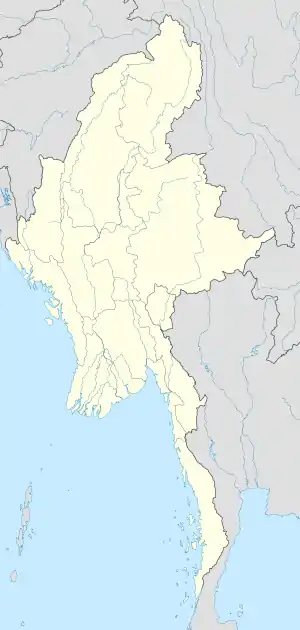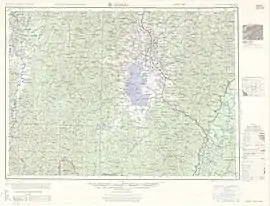Kabaw Valley
The Kabaw Valley also known as Kubo valley[3] is a highland valley in Myanmar's western Sagaing division, close to the border with India's Manipur. The valley is located between Heerok or Yoma ranges of mountains, which constitute the present day border of Manipur, and the Chindwin River (also called the Ningthi River).[4] The valley is home to a number of ethnic groups including the Meitei (Kathe and Paona), the Thadou people, Kuki people, the Mizo, the Kadu and the Kanan.
Kabaw Valley
ကဘော်ချိုင့်ဝှမ်း | |
|---|---|
 Kabaw Valley | |
| Coordinates: 24.10527°N 94.34194°E | |
| Country | Burma |
| Area | |
| • Total | 22,210 km2 (8,580 sq mi) |
| Elevation | 140 m (460 ft) |
During the First Anglo-Burmese War, the Manipuri prince Gambhir Singh conquered the Kabaw valley from Burma. It remained under Manipur control for several years. But the Burmans were able to prove to the British Resident, Major Burney, that the valley had been ceded to Burma by the former Manipur King Marjit Singh in 1813.[5] The British were persuaded to hand the valley back to Burma in 1834.[6][7] The British compensated Manipur for the loss of territory by annual subsidy.[8][9][10][11][12]
History
Kabaw valley, historically, was the border region between Awa ( in present Burma ) and the Muneepoor[13]( Earlier known as Kangleipak or Meitrabak). King Kiyamba (1467–1508), son of King Khomba, was known as the "Conqueror of Kabaw Valley", as he along with his friend, Chaopha Khe Khomba, the king of Pong Kingdom of Pong (Shan Kingdom) of present Myanmar completed the conquest of Kubo valley in year 1475[14] The valley is placed in Manipur according to maps publised in Calcutta as late as 1852[15][16] It also need to be reminded that according to Treaty of Yandabo,[17]Ningthee River was no doubt the natural boundary between Manipur and Burma.[18] There was also an agreement between British and Manipur government in 1834 that if Kabaw valley under any circumstance revert to Manipur, the monthly allowance shall cease.[19]
Communities

At the north end of the valley, lies the Manipuri town of Humine, with the first Burmese town being Zedi.[20][21] The region is mixedly inhabited by the Meeteis, Nepalis, Kukis, Chins, Kados, and Kanans.
Moreh, India is the border town in the Manipur, India side while Tamu is in Myanmar. Both are being referred to as the twin border towns of trade in the border region.
References
- https://www.insidene.com/manipur-demands-compensation-for-kabaw-valley-lost-to-myanmar-during-yandabo-treaty/
- Kabaw Valley, Myanmar (Burma)
- Tassin, Jean-Baptiste; Pemberton, R. Boileau, Map of the territory of Muneepoor, with part of the Kubo valley and Burmese frontier, by captain R. Boileau Pemberton., Calcutta: J.B. Tassin, lith., OCLC 494924053, retrieved 24 November 2020
- Mackenzie, Alexander (1884). History Of The Relations Of The Government With The Hill Tribes Of The North-east Frontier Of Bengal. p. 175.: "The Kubo Valley lies between the Heerok or Yoma range of mountains, which bounds the eastern side of the Manipur Valley, and Ningthee or Ky end wen [Chindwin] River."
- Cocks, Samuel William (1919). A short history of Burma. Cornell University Library. London : Macmillan & Co., Ltd. pp. 59–117.
- Aitchison, C. U. (Comp ) (1931). Collection of Treaties, Engagements and Sanads Relating to India and Neighbouring Countries. Vol. 12 edn: 5. Kerala State Library. Calcutta. p. 202.
- A collection of treaties, engagements, and sanads relating to India and neighbouring countries. Government of India, Calcutta. 1929.
- Brown, R. (1874). Statistical account of the native state of manipur. The Superintendent of Government Press,Calcutta. p. 74.
- Singh, K. M. (Karam Manimohan) (1991). History of the Christian missions in Manipur and neighbouring states. Internet Archive. New Delhi, India : Mittal Publications. p. 419. ISBN 978-81-7099-285-1.
- Banerjee, A. C. (1946) [1943], The Eastern Frontier of British India, 1784–1826 (Second ed.), Calcutta: A. Mukherjee, pp. 492–493 – via archive.org
- BHAT, SUDHAKAR (1975). THE CHALLENGE OF THE NORTHEAST. N.A. pp. 51–54.: "The valley was made part of Burma by the British in 1834. As compensation for the loss of the territory, the British Government undertook to pay to the Ruler of Manipur a sum equivalent to Rs. 6,270 per annum. After the transfer of power, the Government of Burma continued to pay the amount to the Government of India which, in turn, passed on the amount to Manipur State."
- Brown R (1874). Statistical Account Of Manipur. Supritendent Of Government Press, Calcutta. pp. 73–74.: "All the provisions of the above treaty, with the exception of the last, remain in force. The only other arrangement carried out between the British and Manipur Governments in the form of a treaty relates tc the handing over of the Kubo Valley to the Burmese, and the payment of the monthly allowance in lieu. This arrangement bears date 25th January 1834, and stipulates that, should the Kubo Valley from any circumstances again revert to Manipur, the allowance shall cease."
- Tassin, Jean-Baptiste; Pemberton, R. Boileau, Map of the territory of Muneepoor, with part of the Kubo valley and Burmese frontier, by captn R. Boileau Pemberton., Calcutta: J.B. Tassin, lith., OCLC 494924053, retrieved 24 November 2020
- Dave R.k. (1947). Manipur (including Whos Who). New Delhi., Surya Publishers. pp. 7–8.
P.7:" In the year 1475, Ryaamba succeeded in formally annexing Kubbo valley (now in Burma) to Manipur. The relationship between the kingdom of Pong and Manipur were cordial during the reign of Ryaamba." - Johnstone, James (1896). My experiences in Manipur and the Naga hills. University of California Libraries. London : S. Low, Marston and company, limited.
- Johnstone, James (2002). Manipur and the Naga hills. Cornell University Library. New Delhi : Gyan Pub. House. pp. 11–23. ISBN 978-81-212-0121-6.
P.23: "The loneliness, the surrounding savages, and the ill-feeling excited by the Kubo valley (which so late as 1 852 is placed in Manipur, in maps published in Calcutta)" - Cocks, Samuel William (1919). A short history of Burma. Cornell University Library. London : Macmillan & Co., Ltd.
P:117"left to Major Burney for decision was the dispute between Burma and Manipur for the possession of the Kale-Kabaw valley. During the war, Gambhir Singh had been paid by the British government to maintain troops in Manipur, and had enjoyed the services of two British ofl&cers. On the conclusion of peace he was informed that he must carry on the government at his own expense and without assistance. He had, at the end of the war, received the Kale-Kabaw valley as part of his kingdom" - Mackenzie, Alexander (1884). History Of The Relations Of The Government With The Hill Tribes Of The North-east Frontier Of Bengal. pp. 175–176.
P:176"from the signing of the Treaty of Yandaboo in February 1826. The Commissioner in Sylhet, in a letter dated 19th April 1826, remarked that the Ningthee was no doubt the original and natural boundary between Manipur and Burma, and that, if the Burmese were permitted to cross it, it would be difficult to define a line of demarcation that would preclude the possibility of future dispute." - Brown R (1874). Statistical Account Of Manipur. Supritendent Of Government Press, Calcutta.
P: "All the provisions of the above treaty, with the exception of the last, remain in force.The only other arrangement carried out between the British and Manipur Governments in the form of a treaty relates tc the handing over of the Kubo Valley to the Burmese, and the payment of the monthly allowance in lieu. This arrangement bears date 25th January 1834, and stipulates that, should the Kubo Valley from any circumstances again revert to Manipur, the allowance shall cease." - "Burma 1:250,000 topographic map, Series U542, Paungbyin, NG 46-16" U.S. Army Map Service, November 1955
- Tarapot lists the towns of Kahambat, Woktong, Tammu, Mungsa and Samjok at Tarapot, Phanjoubam (2003) Bleeding Manipur Har-Anand Publications, New Delhi, India, page 222, ISBN 81-241-0902-8, but aside from Tammu being Tamu, identification of them is difficult.